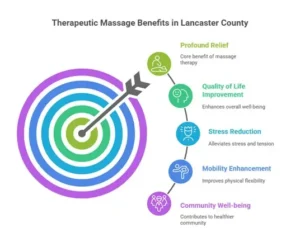Deep Tissue Massage Fundamentals
Deep tissue massage stands apart from relaxation massage through its focused approach to addressing chronic muscular tension and structural imbalances. This therapeutic technique uses firm pressure and slow strokes to reach deeper layers of muscle and fascia, the connective tissue surrounding muscles. Unlike Swedish massage, which primarily promotes relaxation and circulation, deep tissue work specifically targets adhesions and chronic patterns of tension that cause pain and limit movement.
The technique requires skilled application of pressure through fingers, knuckles, fists, and elbows to access tissues that lie beneath superficial muscle layers. Practitioners must understand anatomy, biomechanics, and pain patterns to effectively treat chronic conditions without causing unnecessary discomfort. The goal extends beyond temporary relief to creating lasting changes in tissue quality and function.
Mechanisms of Therapeutic Action
Deep tissue massage works through several physiological mechanisms to produce therapeutic effects. Mechanical pressure breaks up adhesions between muscle fibers and fascial layers, restoring normal tissue mobility. This process, while sometimes uncomfortable during treatment, leads to improved flexibility and reduced pain over time.
Increased blood flow to treated areas brings fresh oxygen and nutrients while removing metabolic waste products that contribute to muscle soreness and inflammation. The pressure also stimulates mechanoreceptors in the tissue, which can help reset muscle tension patterns and improve proprioception. Neurological effects include decreased activity in the sympathetic nervous system and increased parasympathetic activity, promoting relaxation and healing.
Chronic Pain Management Through Deep Tissue Work
Breaking the Pain Cycle
Chronic pain often involves a self-perpetuating cycle where pain causes muscle guarding, which leads to reduced movement, which creates more pain. Deep tissue massage interrupts this cycle by directly addressing the muscular component of chronic pain. Regular sessions help maintain tissue health and prevent the re-establishment of pain patterns.
The sustained pressure used in deep tissue work triggers the release of trigger points, those hypersensitive spots in muscles that refer pain to other areas. By deactivating these points, practitioners can eliminate pain in seemingly unrelated parts of the body. This explains why working on the hip flexors might relieve lower back pain or why treating the shoulders can reduce headaches.
Specific Conditions That Respond Well
Sciatica sufferers often find relief through deep tissue work on the piriformis and other deep hip rotators that can compress the sciatic nerve. The technique can access these deep muscles more effectively than stretching alone. Treatment typically includes work on the entire posterior chain from the lower back through the legs to address all contributing factors.
Plantar fasciitis responds well to deep tissue work on the calf muscles and the plantar fascia itself. Tight calf muscles increase tension on the plantar fascia, so addressing both areas provides more complete relief. The technique can also help break up scar tissue that forms in chronic cases.
Rotator cuff injuries benefit from deep tissue work that addresses not just the rotator cuff muscles but also the surrounding structures that affect shoulder mechanics. Treatment includes work on the chest muscles, upper back, and neck to restore balanced shoulder function.
Stress Relief & Mental Health Benefits
Physical Manifestations of Stress
Stress creates physical tension patterns that become locked in the body’s tissues. Common areas include the shoulders, neck, jaw, and lower back. Deep tissue massage directly addresses these physical holdings, providing relief that goes beyond what relaxation massage alone can achieve. The firm pressure required to reach deep tissues also provides sensory input that many people find grounding and calming.
Chronic stress leads to fascial restrictions throughout the body. Fascia, when healthy, should glide smoothly, but stress causes it to become sticky and restricted. Deep tissue techniques help restore fascial mobility, which can create a profound sense of physical and emotional release.
Neurochemical Changes
Research indicates that deep tissue massage influences neurotransmitter levels in ways that support mental health. Serotonin and dopamine levels increase following treatment, while cortisol levels decrease. These changes contribute to improved mood, better sleep, and reduced anxiety.
The vagus nerve, which plays a crucial role in the relaxation response, responds to the mechanical pressure of deep tissue work. Stimulation of the vagus nerve triggers a cascade of physiological changes that counter the stress response. Heart rate decreases, blood pressure drops, and digestive function improves.
Lancaster’s Deep Tissue Massage Landscape
Qualifications & Training Standards
Quality deep tissue massage requires extensive training beyond basic massage therapy education. Practitioners must understand complex anatomy, including deep muscle layers and their functional relationships. They need skills in assessment to identify which structures require treatment and how much pressure to apply safely.
Continuing education in specialized techniques enhances practitioner effectiveness. Training in trigger point therapy, myofascial release, and structural integration provides additional tools for addressing complex conditions. The best practitioners in Lancaster combine multiple approaches based on individual client needs.
Treatment Customization
Every body responds differently to deep tissue work. Factors including tissue health, pain tolerance, and treatment goals influence how sessions proceed. Skilled practitioners adjust their approach based on tissue response and client feedback throughout the session.
Some clients require gentle, gradual work to prepare tissues for deeper pressure, while others can tolerate and benefit from firm pressure immediately. The key lies in finding the therapeutic edge where the pressure creates change without overwhelming the nervous system. This requires constant communication between practitioner and client.
Maximizing Treatment Benefits
Preparation & Aftercare
Proper hydration before and after deep tissue massage supports the body’s healing processes. Water helps flush metabolic waste released during treatment and maintains tissue pliability. Some temporary soreness following treatment is normal and typically resolves within 24-48 hours.
Heat application before sessions can help prepare tissues for deep work, while ice may help manage any post-treatment inflammation. Gentle stretching and movement following sessions helps maintain the mobility gains achieved during treatment. Epsom salt baths can provide additional muscle relaxation and support recovery.
Frequency & Treatment Planning
Initial treatment phases often require weekly sessions to address chronic patterns and establish positive changes. As conditions improve, session frequency can decrease to bi-weekly or monthly maintenance appointments. Some conditions require intensive treatment periods followed by regular maintenance to prevent recurrence.
The number of sessions needed varies based on condition severity, duration, and individual healing capacity. Acute conditions may resolve in a few sessions, while chronic patterns developed over years require longer treatment courses. Realistic expectations and commitment to the treatment process contribute to successful outcomes.
Complementary Therapies & Lifestyle Factors
Movement & Exercise Integration
Deep tissue massage works best when combined with appropriate movement and exercise. The increased tissue mobility gained through massage allows for more effective stretching and strengthening. Practitioners often provide specific exercises that support the changes achieved during sessions.
Yoga, Pilates, and other movement practices complement deep tissue work by maintaining flexibility and body awareness between sessions. These practices help clients recognize when tension patterns begin to re-establish and take corrective action before pain develops.
Nutrition & Inflammation Management
Diet affects tissue health and inflammatory processes that contribute to chronic pain. Anti-inflammatory foods support the healing process initiated by deep tissue work. Adequate protein intake provides building blocks for tissue repair and regeneration.
Certain supplements may support treatment outcomes. Magnesium helps with muscle relaxation, while omega-3 fatty acids reduce inflammation. However, dietary changes and supplementation should complement, not replace, professional treatment.
Lancaster residents dealing with chronic pain and stress have access to skilled deep tissue massage practitioners who can provide significant relief. The technique’s ability to address both physical and emotional components of chronic conditions makes it valuable for comprehensive health management. When combined with appropriate self-care and lifestyle modifications, deep tissue massage offers a path to reduced pain, improved function, and enhanced quality of life. The key lies in finding experienced practitioners who can customize treatment to individual needs and goals while maintaining open communication throughout the healing process.








